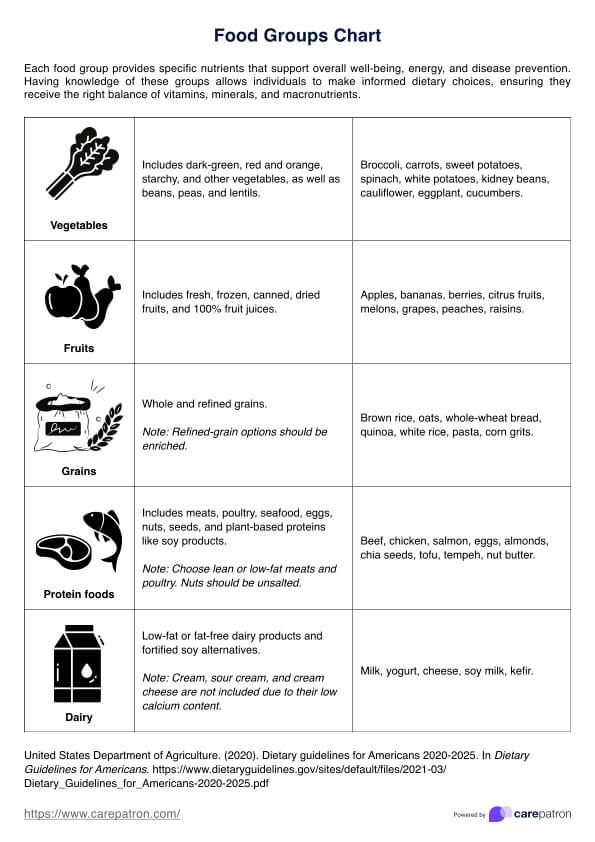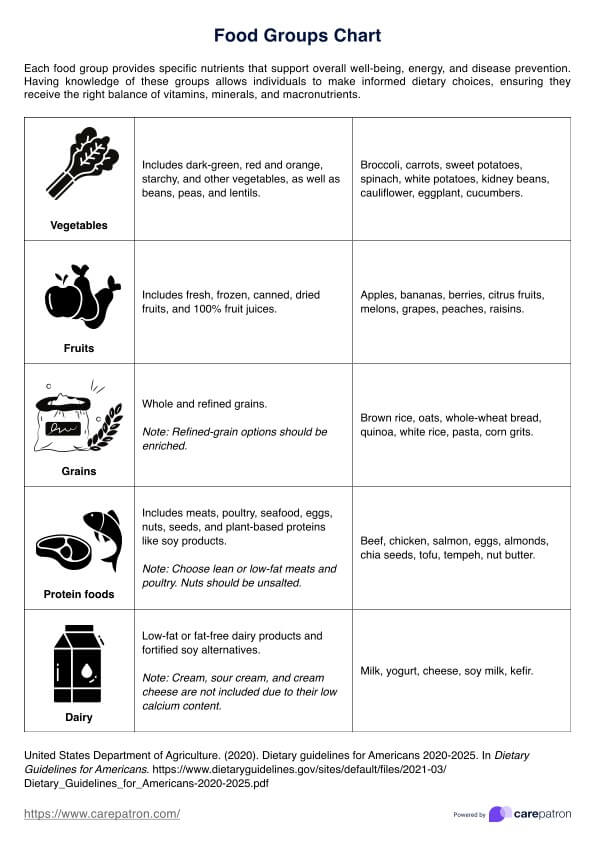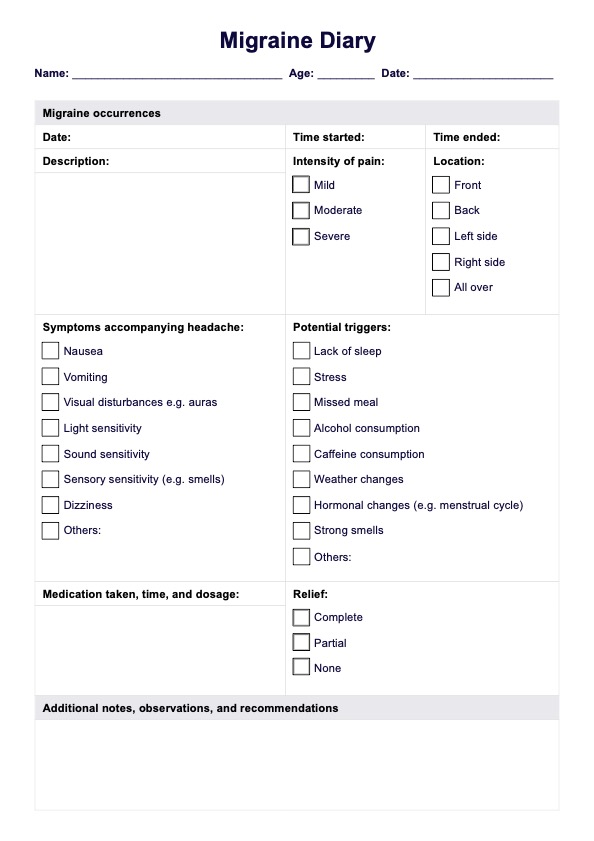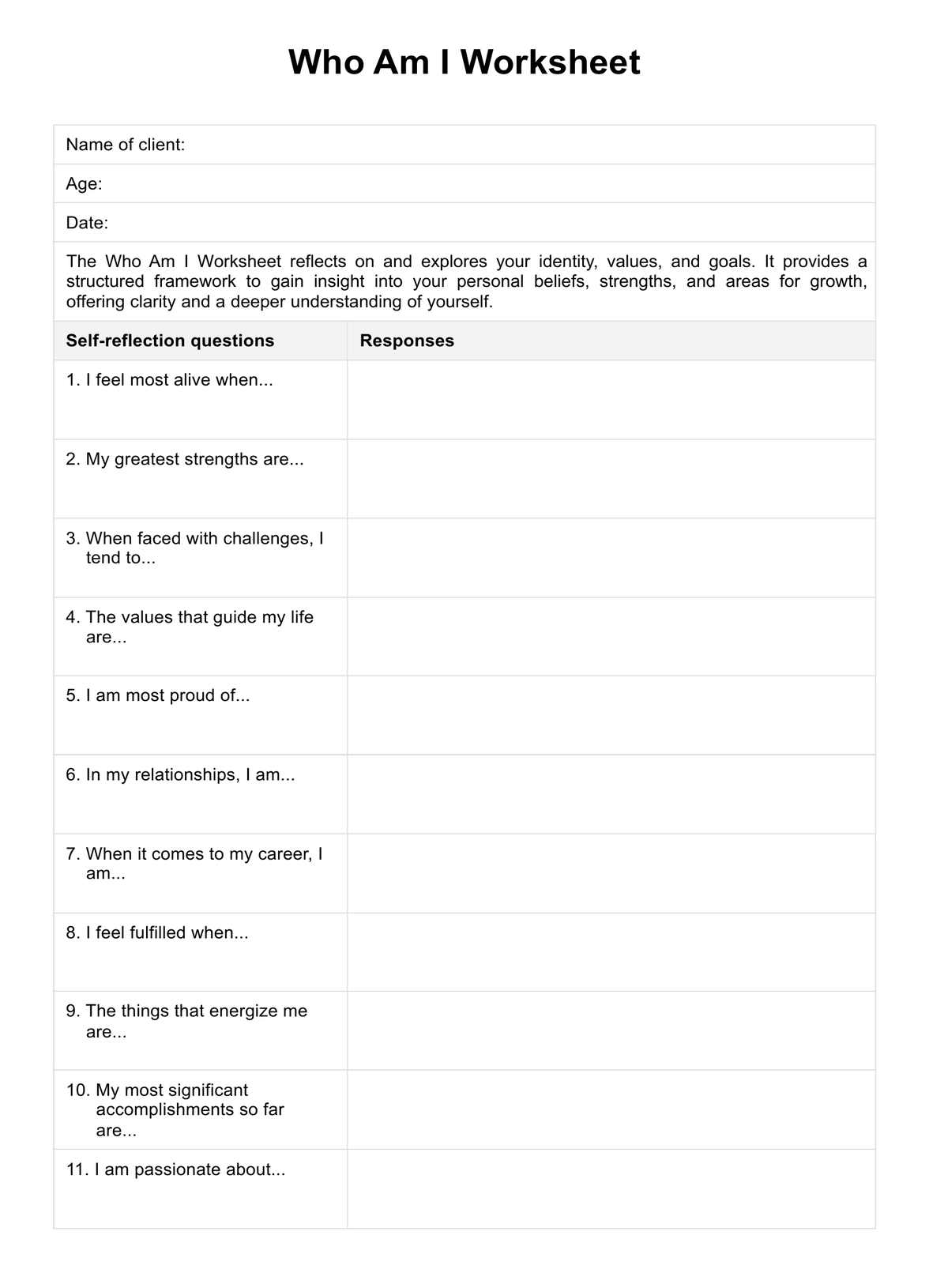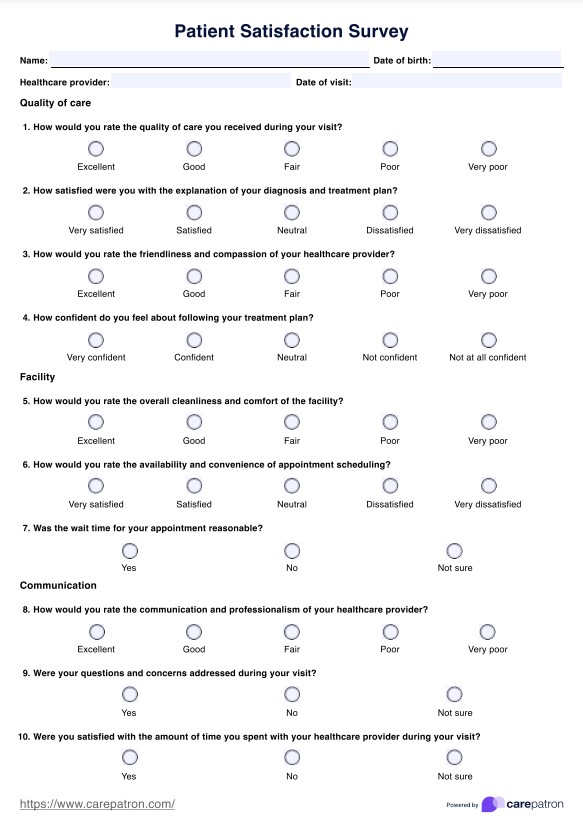Food Groups Chart
Help clients achieve optimal health with balanced nutrition. Guide them to enjoy diverse foods in moderation using the Food Groups Chart for lasting well-being.


What are the five food groups?
Each food group provides specific nutrients that support overall well-being, energy, and disease prevention. Incorporating various foods from each group into your patient's meal prep ensures that the body receives the necessary nutrients for optimal health and wellness. Here are the main five food groups as outlined by the United States Department of Agriculture (2020):
Vegetables
Another major food group is vegetables. This group encompasses many options, including red and orange, starchy, dark green vegetables like spinach and broccoli, and other varieties such as carrots, eggplants, and tomatoes. Vegetables are rich in vitamins, minerals, and antioxidants, promoting overall health and well-being.
Fruits
The fruit group is one of the five food groups outlined in the food guide pyramid, a visual representation of healthy eating. It includes a variety of fruits such as apples, bananas, oranges, berries, and more. Fruits are filled with essential vitamins, minerals, and fiber, making them a nutritious choice for snacks or as part of meals.
Grains
The grains group forms the foundation of the food pyramid, emphasizing their importance in a healthy diet. This group includes whole grains like brown rice, quinoa, oats and refined grains like white bread and pasta. Whole grains are particularly beneficial, providing fiber and essential nutrients that refined grains may lack.
Protein foods
Protein foods are vital for muscle repair, growth, and overall body function. Good sources of this food group include lean meats, poultry, fish, and tofu. Processed meats are often high in saturated fats, which can negatively impact heart health if consumed excessively. Incorporating protein-rich foods into meals helps maintain muscle mass and supports a healthy metabolism.
Dairy
The dairy group includes milk, yogurt, cheese, and fortified plant-based milk alternatives. These are excellent sources of calcium, protein, and vitamins like vitamin D. Consuming dairy products contributes to strong bones and teeth, making it an essential part of a balanced diet.
In addition to these five, oils are necessary for a healthy diet because they provide essential fatty acids and vitamin E (Chang, 2017).
Food Groups Chart Template
Food Groups Chart Example
How does this Food Group Chart work?
A balanced diet is critical for your client's overall health and well-being. The Food Groups Chart provided here offers a convenient tool to help you assist them in planning nutritious meals. Follow these steps to utilize the chart effectively:
Step 1: Download the template
Start by downloading or printing the Food Groups Chart to have it on hand for reference. Make sure it's easily accessible in your office, on your computer, or as a handout for clients. You can also save a digital version for quick access during consultations.
Step 2: Identify the food groups
Look at the five main food groups: vegetables, fruits, grains, protein foods, and dairy. Take a moment to review each group and familiarize yourself with the examples listed. This will help you quickly identify which foods belong to which group when planning meals or advising clients.
Step 3: Plan meals around the groups
Use the chart to create meals that include a variety of foods from each group. Emphasize the necessity of fruits, varied vegetables, whole grains, and diverse protein sources to promote a balanced diet and long-term health. For example, include leafy greens and carrots (vegetables), an apple (fruit), brown rice (whole grains), grilled chicken (protein foods), and yogurt (dairy). Doing this ensures a balanced meal with essential nutrients from different categories.
Step 4: Adjust portion sizes and preferences
Tailor the portions and choices based on individual dietary needs or preferences. If a client prefers plant-based proteins, use options like tofu from the protein foods group. Encourage your clients to fill half their plates with fruits and vegetables, switch to low-fat or fat-free dairy options, and use the USDA's MyPlate Plan.
Step 5: Reassess regularly
Revisit the chart periodically to ensure you cover different foods and that they do not have an excessive intake for one category. Keeping meals varied helps maintain nutritional balance and keeps the diet interesting.
Who can use this printable chart?
The chart is an excellent addition to a healthcare professional's toolkit. Here are three healthcare professionals who can use the printable Food Groups Chart:
Dietitians
Dietitians can use the chart to guide clients in creating balanced meal plans tailored to their nutritional needs. By showing clients the importance of including various foods from each group, they can help prevent nutrient deficiencies.
Doctors
Doctors can use the chart during patient consultations to emphasize the importance of a balanced diet for managing health conditions like diabetes or heart disease. By visualizing food groups, patients can better understand how to make healthier choices that align with their treatment plans.
Health coaches
They can incorporate the chart into their sessions to help clients set realistic dietary goals and improve their eating habits. It is handy when discussing meal ideas and snacks, encouraging clients to include a wide range of foods.
What are the benefits of using a Food Groups Chart?
The five food groups form the foundation of a healthy eating pattern. Understanding food groups and their nutritional value is essential for maintaining a balanced and nutritious diet. Here's how the Food Groups Chart can be beneficial in various ways.
Balanced diet guidance
It helps ensure individuals consume the right mix of nutrients by categorizing foods into essential groups. This makes creating meals that meet dietary recommendations and support well-being easier.
Simplifies meal planning
The chart takes the guesswork out of deciding what to eat by providing clear categories of foods to include in daily meals. It helps people eat healthy meals with various foods that complement each other nutritionally. This is particularly useful for those with busy lifestyles or specific dietary goals, such as weight management.
Promotes healthier choices
When people understand different food groups, they are more likely to choose whole, nutrient-dense foods like vegetables, fruits, whole grains, and lean proteins. This awareness guides individuals away from processed and refined foods, leading to better health outcomes. This awareness fosters habits that contribute to long-term health and wellness, especially for those with chronic diseases.
Supports client education
For healthcare professionals, the chart is valuable when explaining nutrition to clients. It simplifies discussions about healthy eating and helps clients visualize what they should incorporate into their meals.
References
Chang, S. (2017, September 26). Back to basics: All about MyPlate food groups. United States Department of Agriculture. https://www.usda.gov/media/blog/2017/09/26/back-basics-all-about-myplate-food-groups
United States Department of Agriculture. (2020). Dietary guidelines for Americans 2020 -2025. In Dietary Guidelines for Americans. https://www.dietaryguidelines.gov/sites/default/files/2021-03/Dietary_Guidelines_for_Americans-2020-2025.pdf
Commonly asked questions
Food groups provide essential nutrients that support overall health and well-being by ensuring a diverse intake of vitamins, minerals, and other nutrients.
The recommended servings vary depending on age, sex, and activity level. However, aim for various foods from each group throughout the day.
While each food group offers valuable nutrients, it's essential to consume various foods from all groups to ensure a well-rounded intake of nutrients.


